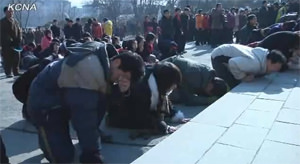Grieving for the Dear Leader
Since North Korean dictator Kim Jong Il's death last weekend, images of his countrymen grieving en masse have passed through the country's ironclad borders to the outside world, provoking a range of reactions -- incredulity and puzzlement among them. So what's the story behind the weeping and gnashing of teeth?
Since North Korean dictator Kim Jong Il’s death last weekend, images of his countrymen grieving en masse have passed through the country’s ironclad borders to the outside world, provoking a range of reactions — incredulity and puzzlement among them. So what’s the story behind the weeping and gnashing of teeth? Here’s some timely sociocultural analysis courtesy of GlobalPost. –KA
GlobalPost:
Pyongyang dwellers tend to see themselves as having a vested interest in maintenance of the Kim family regime. Defector reports suggest that many of them had few illusions about Kim Jong Il, considering him a leader far inferior to his late father.
Still, it could have come as a genuine shock to some to realize they must contemplate life without Kim Jong Il, a known quantity at least, in charge of the country. Most of them know little about his son and heir Kim Jong Un, who is only about 29 years old and notably inexperienced in affairs of state.
The third factor: Especially if it continues for more than another day or two, much of the grieving display can be put down to a combination of indoctrination and coercion.
Oh Young Nam, a police officer who defected to South Korea, in an interview not long afterward described the scene following the 1994 death of Kim’s father and predecessor as dictator. “The media showed North Koreans weeping in front of the statue of Kim Il Sung,” Oh said.
Your support matters…
Independent journalism is under threat and overshadowed by heavily funded mainstream media.
You can help level the playing field. Become a member.
Your tax-deductible contribution keeps us digging beneath the headlines to give you thought-provoking, investigative reporting and analysis that unearths what's really happening- without compromise.
Give today to support our courageous, independent journalists.






You need to be a supporter to comment.
There are currently no responses to this article.
Be the first to respond.